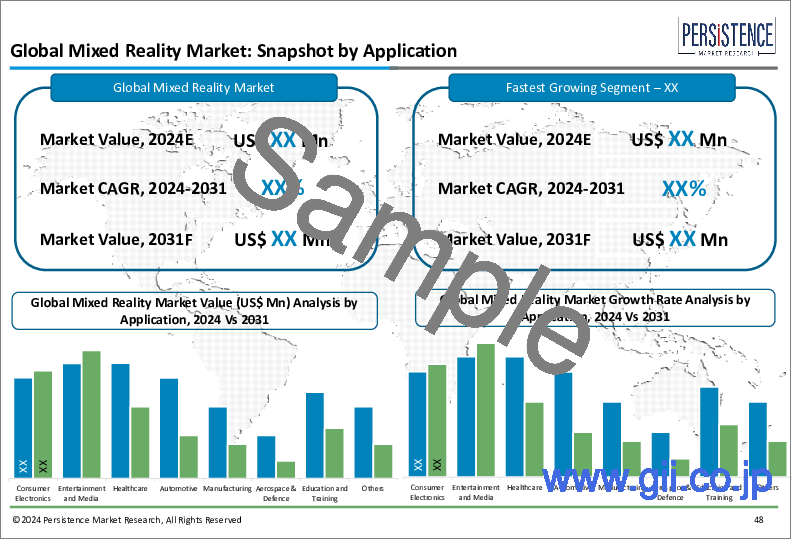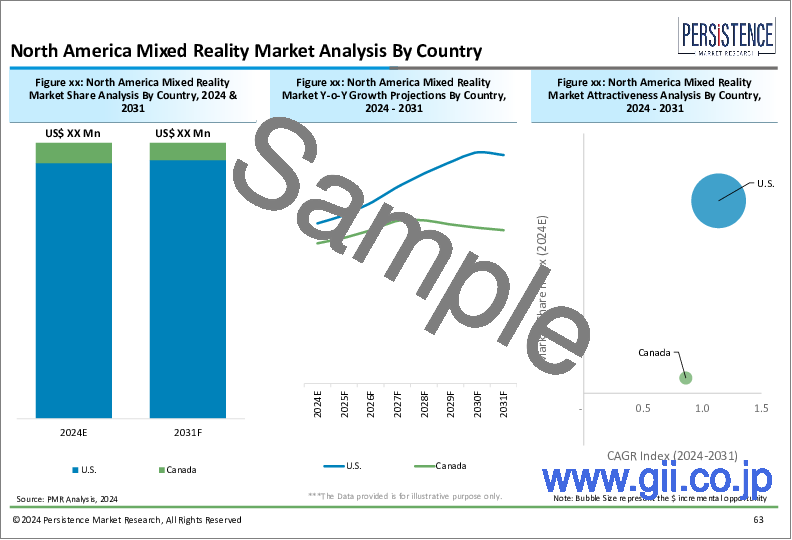|
|
市場調査レポート
商品コード
1508700
複合現実(Mixed Reality)市場:世界の産業分析、規模、シェア、成長、動向、予測、2024年~2032年Mixed Reality Market: Global Industry Analysis, Size, Share, Growth, Trends, and Forecast, 2024-2032 |
||||||
カスタマイズ可能
|
|||||||
| 複合現実(Mixed Reality)市場:世界の産業分析、規模、シェア、成長、動向、予測、2024年~2032年 |
|
出版日: 2024年07月04日
発行: Persistence Market Research
ページ情報: 英文 250 Pages
納期: 2~5営業日
|
- 全表示
- 概要
- 目次
Persistence Market Research社は、複合現実(Mixed Reality)の世界市場に関する包括的なレポートを発表しました。当レポートでは、市場促進要因・動向・機会・課題を含む重要な市場ダイナミクスを徹底的に評価し、市場構造に関する詳細な洞察を提供しています。
主な洞察
- 複合現実市場規模(2024年):22億米ドル
- 予測市場規模(2032年):253億米ドル
- 世界市場成長率(CAGR 2024年~2032年):31.2%
複合現実(Mixed Reality)市場 - 調査範囲:
複合現実技術は、仮想現実と拡張現実を統合し、物理的世界とデジタル世界を融合させた没入型のユーザー体験を可能にします。これらの技術は、ゲーム、ヘルスケア、教育、製造、小売などの産業で応用されています。市場は、ヘッドマウントディスプレイ(HMD)、ソフトウェアプラットフォーム、開発者ツールなどのソリューションを提供し、個人消費者から企業顧客まで多様なユーザーに対応しています。
市場促進要因:
世界の複合現実(Mixed Reality)市場は、ゲームやエンターテインメント分野での採用拡大、企業における遠隔コラボレーションツールの需要拡大、HMDや空間コンピューティング技術の進歩など、いくつかの重要な要因によって推進されています。これらの技術革新により、ユーザーとのインタラクションが強化され、生産性が向上し、多様な用途で市場拡大が促進されます。
市場抑制要因:
有望な成長見通しにもかかわらず、複合現実(Mixed Reality)市場は、ハードウェアの高コスト、プライバシーやデータセキュリティに対する懸念、既存システムとのシームレスな統合を実現する上での技術的障壁などに関連する課題に直面しています。また、規制の複雑さや強固なインフラの必要性も、特に新興市場における普及の障壁となっています。
市場機会:
複合現実(Mixed Reality)市場は、5G技術の進歩、大手テクノロジー企業による研究開発投資の増加、エンターテインメントから遠隔トレーニング、バーチャルツーリズム、バーチャルヘルスケアなどの分野への応用範囲の拡大が大きな成長機会をもたらしています。戦略的パートナーシップ、合併、買収は、技術革新を促進し、市場範囲を拡大する上で極めて重要です。
本レポートで扱う主な質問
- 混合現実市場の世界的成長を促進する主な要因は何か?
- 混合現実技術の採用を促進している産業と用途は何か?
- ハードウェアとソフトウェアの進歩は競合情勢をどのように変えているか?
- 複合現実(Mixed Reality)市場に貢献している主要企業はどこか、また、市場の主導権を維持するためにどのような戦略をとっているのか?
- 世界の混合現実市場の新たな動向と将来展望は?
目次
第1章 エグゼクティブサマリー
第2章 市場概要
- 市場範囲/ 分類
- 市場の定義/ 範囲/ 制限
第3章 市場背景
- 市場力学
- シナリオ予測
- 機会マップ分析
- 投資実現可能性マトリックス
- PESTLEとポーター分析
- 規制状況
- 地域親市場見通し
第4章 世界の複合現実市場分析
- 過去の市場規模分析(2019年~2023年)
- 現在および将来の市場規模予測(2024年~2032年)
- 前年比成長動向分析
- 絶対額の機会分析
第5章 世界の複合現実市場分析:コンポーネント別
- イントロダクション/主な調査結果
- 過去の市場規模分析:コンポーネント別(2019年~2023年)
- 現在および将来の市場規模価分析と予測:コンポーネント別(2024年~2032年)
- ハードウェア
- ソフトウェア
- 前年比成長動向分析:コンポーネント別(2019年~2023年)
- 絶対額の機会分析:コンポーネント別(2024年~2032年)
第6章 世界の複合現実市場分析:デバイスタイプ別
- イントロダクション/主な調査結果
- 過去の市場規模分析:デバイスタイプ別(2019年~2023年)
- 現在および将来の市場規模価分析と予測:デバイスタイプ別(2024年~2032年)
- 有線
- 無線
- 前年比成長動向分析:デバイスタイプ別(2019年~2023年)
- 絶対額の機会分析:デバイスタイプ別(2024年~2032年)
第7章 世界の複合現実市場分析:用途別
- イントロダクション/主な調査結果
- 過去の市場規模分析:用途別(2019年~2023年)
- 現在および将来の市場規模価分析と予測:用途別(2024年~2032年)
- 航空宇宙・防衛
- 建物
- エンターテイメントとゲーム
- 医療
- その他
- 前年比成長動向分析:用途別(2019年~2023年)
- 絶対額の機会分析:用途別(2024年~2032年)
第8章 世界の複合現実市場分析:地域別
- イントロダクション
- 過去の市場規模分析:地域別(2019年~2023年)
- 現在および将来の市場規模価分析と予測:地域別(2024年~2032年)
- 北米
- ラテンアメリカ
- 欧州
- アジア太平洋
- 中東・アフリカ
- 地域別の市場の魅力分析
第9章 北米の複合現実市場分析(国別)
第10章 ラテンアメリカの複合現実市場分析(国別)
第11章 欧州の複合現実市場分析(国別)
第12章 アジア太平洋の複合現実市場分析(国別)
第13章 中東・アフリカの複合現実市場分析(国別)
第14章 主要国の複合現実市場分析
- 米国
- カナダ
- ブラジル
- メキシコ
- ドイツ
- 英国
- フランス
- スペイン
- イタリア
- 中国
- 日本
- 韓国
- シンガポール
- タイ
- インドネシア
- オーストラリア
- ニュージーランド
- GCC諸国
- 南アフリカ
- イスラエル
第15章 市場構造分析
- 競合ダッシュボード
- 競合ベンチマーク
- 主要企業の市場シェア分析
第16章 競合分析
- 競合の詳細
- HTC Corporation
- Intel Corporation
- Magic leap, Inc.
- Microsoft Corporation
- Eon Reality, Inc.
- Google Inc.
- Samsung Electronics Co. Ltd.
- Seiko Epson Corporation
- Meta Company
- Accenture PLC
- Sony Corporation
- HP Development Company LP
- Dell Technologies Inc.
- Amber Garage
- Occipital Inc.
第17章 前提と頭字語
第18章 調査手法
Persistence Market Research has recently released a comprehensive report on the worldwide market for mixed reality. The report offers a thorough assessment of crucial market dynamics, including drivers, trends, opportunities, and challenges, providing detailed insights into the market structure.
Key Insights:
- Mixed Reality Market Size (2024E): USD 2.2 Billion
- Projected Market Value (2032F): USD 25.3 Billion
- Global Market Growth Rate (CAGR 2024 to 2032): 31.2%
Mixed Reality Market - Report Scope:
Mixed reality technologies integrate virtual and augmented reality, enabling immersive user experiences that blend physical and digital worlds. These technologies find applications across industries such as gaming, healthcare, education, manufacturing, and retail. The market caters to a diverse range of users, from individual consumers to enterprise clients, offering solutions like head-mounted displays (HMDs), software platforms, and developer tools.
Market Growth Drivers:
The global mixed reality market is propelled by several key factors, including increasing adoption in gaming and entertainment sectors, growing demand for remote collaboration tools in enterprises, and advancements in HMDs and spatial computing technologies. These innovations enhance user interaction, improve productivity, and drive market expansion across diverse applications.
Market Restraints:
Despite promising growth prospects, the mixed reality market faces challenges related to high costs of hardware, concerns over privacy and data security, and technological barriers in achieving seamless integration with existing systems. Regulatory complexities and the need for robust infrastructure also pose barriers to widespread adoption, particularly in emerging markets.
Market Opportunities:
The mixed reality market presents significant growth opportunities driven by advancements in 5G technology, increasing investments in R&D by major technology companies, and the expanding application scope beyond entertainment to areas such as remote training, virtual tourism, and virtual healthcare consultations. Strategic partnerships, mergers, and acquisitions are pivotal in fostering innovation and expanding market reach.
Key Questions Answered in the Report:
- What are the primary factors driving the growth of the mixed reality market globally?
- Which industries and applications are driving adoption of mixed reality technologies?
- How are advancements in hardware and software reshaping the competitive landscape?
- Who are the key players contributing to the mixed reality market, and what strategies are they employing to maintain market leadership?
- What are the emerging trends and future prospects in the global mixed reality market?
Competitive Intelligence and Business Strategy:
Leading players in the global mixed reality market, including Microsoft Corporation, Meta Platforms, Inc., and Magic Leap, Inc., focus on innovation, ecosystem development, and strategic alliances to gain competitive advantage. These companies invest in content development, platform enhancements, and user experience improvements to drive adoption across diverse markets and applications. Collaborations with content developers, industry partners, and educational institutions are critical in expanding market presence and driving technological innovation.
Key Companies Profiled:
- HTC Corporation
- Intel Corporation
- Magic Leap, Inc.
- Microsoft Corporation
- Eon Reality Inc.
- Google Inc.
- Samsung Electronics Co. Ltd.
- Seiko Epson Corporation
- Meta Company
- Accenture PLC
- Sony Corporation
- HP Development Company LP
- Dell Technologies Inc.
- Amber Garage
- Occipital Inc.
Mixed Reality Market Segmentation:
By Component:
- Hardware
- Software
By Device Type:
- Wired
- Wireless
By Application:
- Aerospace & Defence
- Architecture
- Entertainment & Gaming
- Medical
By Region:
- North America
- Latin America
- Europe
- Asia Pacific
- Middle East and Africa
Table of Contents
1. Executive Summary
- 1.1. Global Market Outlook
- 1.2. Demand-side Trends
- 1.3. Supply-side Trends
- 1.4. Technology Roadmap Analysis
- 1.5. Analysis and Recommendations
2. Market Overview
- 2.1. Market Coverage / Taxonomy
- 2.2. Market Definition / Scope / Limitations
3. Market Background
- 3.1. Market Dynamics
- 3.1.1. Drivers
- 3.1.2. Restraints
- 3.1.3. Opportunity
- 3.1.4. Trends
- 3.2. Scenario Forecast
- 3.2.1. Demand in Optimistic Scenario
- 3.2.2. Demand in Likely Scenario
- 3.2.3. Demand in Conservative Scenario
- 3.3. Opportunity Map Analysis
- 3.4. Investment Feasibility Matrix
- 3.5. PESTLE and Porter's Analysis
- 3.6. Regulatory Landscape
- 3.6.1. By Key Regions
- 3.6.2. By Key Countries
- 3.7. Regional Parent Market Outlook
4. Global Mixed Reality Market Analysis 2019-2023 and Forecast, 2024-2032
- 4.1. Historical Market Size Value (US$ million) Analysis, 2019-2023
- 4.2. Current and Future Market Size Value (US$ million) Projections, 2024-2032
- 4.2.1. Y-o-Y Growth Trend Analysis
- 4.2.2. Absolute $ Opportunity Analysis
5. Global Mixed Reality Market Analysis 2019-2023 and Forecast 2024-2032, By Component
- 5.1. Introduction / Key Findings
- 5.2. Historical Market Size Value (US$ million) Analysis By Component, 2019-2023
- 5.3. Current and Future Market Size Value (US$ million) Analysis and Forecast By Component, 2024-2032
- 5.3.1. Hardware
- 5.3.2. Software
- 5.4. Y-o-Y Growth Trend Analysis By Component, 2019-2023
- 5.5. Absolute $ Opportunity Analysis By Component, 2024-2032
6. Global Mixed Reality Market Analysis 2019-2023 and Forecast 2024-2032, By Device Type
- 6.1. Introduction / Key Findings
- 6.2. Historical Market Size Value (US$ million) Analysis By Device Type, 2019-2023
- 6.3. Current and Future Market Size Value (US$ million) Analysis and Forecast By Device Type, 2024-2032
- 6.3.1. Wired
- 6.3.2. Wireless
- 6.4. Y-o-Y Growth Trend Analysis By Device Type, 2019-2023
- 6.5. Absolute $ Opportunity Analysis By Device Type, 2024-2032
7. Global Mixed Reality Market Analysis 2019-2023 and Forecast 2024-2032, By Application
- 7.1. Introduction / Key Findings
- 7.2. Historical Market Size Value (US$ million) Analysis By Application, 2019-2023
- 7.3. Current and Future Market Size Value (US$ million) Analysis and Forecast By Application, 2024-2032
- 7.3.1. Aerospace & Defense
- 7.3.2. Architecture
- 7.3.3. Entertainment & Gaming
- 7.3.4. Medical
- 7.3.5. Others
- 7.4. Y-o-Y Growth Trend Analysis By Application, 2019-2023
- 7.5. Absolute $ Opportunity Analysis By Application, 2024-2032
8. Global Mixed Reality Market Analysis 2019-2023 and Forecast 2024-2032, By Region
- 8.1. Introduction
- 8.2. Historical Market Size Value (US$ million) Analysis By Region, 2019-2023
- 8.3. Current Market Size Value (US$ million) Analysis and Forecast By Region, 2024-2032
- 8.3.1. North America
- 8.3.2. Latin America
- 8.3.3. Europe
- 8.3.4. Asia Pacific
- 8.3.5. Middle East & Africa
- 8.4. Market Attractiveness Analysis By Region
9. North America Mixed Reality Market Analysis 2019-2023 and Forecast 2024-2032, By Country
- 9.1. Historical Market Size Value (US$ million) Trend Analysis By Market Taxonomy, 2019-2023
- 9.2. Market Size Value (US$ million) Forecast By Market Taxonomy, 2024-2032
- 9.2.1. By Country
- 9.2.1.1. United States
- 9.2.1.2. Canada
- 9.2.2. By Component
- 9.2.3. By Device Type
- 9.2.4. By Application
- 9.2.1. By Country
- 9.3. Market Attractiveness Analysis
- 9.3.1. By Country
- 9.3.2. By Component
- 9.3.3. By Device Type
- 9.3.4. By Application
- 9.4. Key Takeaways
10. Latin America Mixed Reality Market Analysis 2019-2023 and Forecast 2024-2032, By Country
- 10.1. Historical Market Size Value (US$ million) Trend Analysis By Market Taxonomy, 2019-2023
- 10.2. Market Size Value (US$ million) Forecast By Market Taxonomy, 2024-2032
- 10.2.1. By Country
- 10.2.1.1. Brazil
- 10.2.1.2. Mexico
- 10.2.1.3. Rest of Latin America
- 10.2.2. By Component
- 10.2.3. By Device Type
- 10.2.4. By Application
- 10.2.1. By Country
- 10.3. Market Attractiveness Analysis
- 10.3.1. By Country
- 10.3.2. By Component
- 10.3.3. By Device Type
- 10.3.4. By Application
- 10.4. Key Takeaways
11. Europe Mixed Reality Market Analysis 2019-2023 and Forecast 2024-2032, By Country
- 11.1. Historical Market Size Value (US$ million) Trend Analysis By Market Taxonomy, 2019-2023
- 11.2. Market Size Value (US$ million) Forecast By Market Taxonomy, 2024-2032
- 11.2.1. By Country
- 11.2.1.1. Germany
- 11.2.1.2. United Kingdom
- 11.2.1.3. France
- 11.2.1.4. Spain
- 11.2.1.5. Italy
- 11.2.1.6. Rest of Europe
- 11.2.2. By Component
- 11.2.3. By Device Type
- 11.2.4. By Application
- 11.2.1. By Country
- 11.3. Market Attractiveness Analysis
- 11.3.1. By Country
- 11.3.2. By Component
- 11.3.3. By Device Type
- 11.3.4. By Application
- 11.4. Key Takeaways
12. Asia Pacific Mixed Reality Market Analysis 2019-2023 and Forecast 2024-2032, By Country
- 12.1. Historical Market Size Value (US$ million) Trend Analysis By Market Taxonomy, 2019-2023
- 12.2. Market Size Value (US$ million) Forecast By Market Taxonomy, 2024-2032
- 12.2.1. By Country
- 12.2.1.1. China
- 12.2.1.2. Japan
- 12.2.1.3. South Korea
- 12.2.1.4. Singapore
- 12.2.1.5. Thailand
- 12.2.1.6. Indonesia
- 12.2.1.7. Australia
- 12.2.1.8. New Zealand
- 12.2.1.9. Rest of Asia Pacific
- 12.2.2. By Component
- 12.2.3. By Device Type
- 12.2.4. By Application
- 12.2.1. By Country
- 12.3. Market Attractiveness Analysis
- 12.3.1. By Country
- 12.3.2. By Component
- 12.3.3. By Device Type
- 12.3.4. By Application
- 12.4. Key Takeaways
13. Middle East & Africa Mixed Reality Market Analysis 2019-2023 and Forecast 2024-2032, By Country
- 13.1. Historical Market Size Value (US$ million) Trend Analysis By Market Taxonomy, 2019-2023
- 13.2. Market Size Value (US$ million) Forecast By Market Taxonomy, 2024-2032
- 13.2.1. By Country
- 13.2.1.1. GCC Countries
- 13.2.1.2. South Africa
- 13.2.1.3. Israel
- 13.2.1.4. Rest of Middle East & Africa
- 13.2.2. By Component
- 13.2.3. By Device Type
- 13.2.4. By Application
- 13.2.1. By Country
- 13.3. Market Attractiveness Analysis
- 13.3.1. By Country
- 13.3.2. By Component
- 13.3.3. By Device Type
- 13.3.4. By Application
- 13.4. Key Takeaways
14. Key Countries Mixed Reality Market Analysis
- 14.1. United States
- 14.1.1. Pricing Analysis
- 14.1.2. Market Share Analysis, 2024
- 14.1.2.1. By Component
- 14.1.2.2. By Device Type
- 14.1.2.3. By Application
- 14.2. Canada
- 14.2.1. Pricing Analysis
- 14.2.2. Market Share Analysis, 2024
- 14.2.2.1. By Component
- 14.2.2.2. By Device Type
- 14.2.2.3. By Application
- 14.3. Brazil
- 14.3.1. Pricing Analysis
- 14.3.2. Market Share Analysis, 2024
- 14.3.2.1. By Component
- 14.3.2.2. By Device Type
- 14.3.2.3. By Application
- 14.4. Mexico
- 14.4.1. Pricing Analysis
- 14.4.2. Market Share Analysis, 2024
- 14.4.2.1. By Component
- 14.4.2.2. By Device Type
- 14.4.2.3. By Application
- 14.5. Germany
- 14.5.1. Pricing Analysis
- 14.5.2. Market Share Analysis, 2024
- 14.5.2.1. By Component
- 14.5.2.2. By Device Type
- 14.5.2.3. By Application
- 14.6. United Kingdom
- 14.6.1. Pricing Analysis
- 14.6.2. Market Share Analysis, 2024
- 14.6.2.1. By Component
- 14.6.2.2. By Device Type
- 14.6.2.3. By Application
- 14.7. France
- 14.7.1. Pricing Analysis
- 14.7.2. Market Share Analysis, 2024
- 14.7.2.1. By Component
- 14.7.2.2. By Device Type
- 14.7.2.3. By Application
- 14.8. Spain
- 14.8.1. Pricing Analysis
- 14.8.2. Market Share Analysis, 2024
- 14.8.2.1. By Component
- 14.8.2.2. By Device Type
- 14.8.2.3. By Application
- 14.9. Italy
- 14.9.1. Pricing Analysis
- 14.9.2. Market Share Analysis, 2024
- 14.9.2.1. By Component
- 14.9.2.2. By Device Type
- 14.9.2.3. By Application
- 14.10. China
- 14.10.1. Pricing Analysis
- 14.10.2. Market Share Analysis, 2024
- 14.10.2.1. By Component
- 14.10.2.2. By Device Type
- 14.10.2.3. By Application
- 14.11. Japan
- 14.11.1. Pricing Analysis
- 14.11.2. Market Share Analysis, 2024
- 14.11.2.1. By Component
- 14.11.2.2. By Device Type
- 14.11.2.3. By Application
- 14.12. South Korea
- 14.12.1. Pricing Analysis
- 14.12.2. Market Share Analysis, 2024
- 14.12.2.1. By Component
- 14.12.2.2. By Device Type
- 14.12.2.3. By Application
- 14.13. Singapore
- 14.13.1. Pricing Analysis
- 14.13.2. Market Share Analysis, 2024
- 14.13.2.1. By Component
- 14.13.2.2. By Device Type
- 14.13.2.3. By Application
- 14.14. Thailand
- 14.14.1. Pricing Analysis
- 14.14.2. Market Share Analysis, 2024
- 14.14.2.1. By Component
- 14.14.2.2. By Device Type
- 14.14.2.3. By Application
- 14.15. Indonesia
- 14.15.1. Pricing Analysis
- 14.15.2. Market Share Analysis, 2024
- 14.15.2.1. By Component
- 14.15.2.2. By Device Type
- 14.15.2.3. By Application
- 14.16. Australia
- 14.16.1. Pricing Analysis
- 14.16.2. Market Share Analysis, 2024
- 14.16.2.1. By Component
- 14.16.2.2. By Device Type
- 14.16.2.3. By Application
- 14.17. New Zealand
- 14.17.1. Pricing Analysis
- 14.17.2. Market Share Analysis, 2024
- 14.17.2.1. By Component
- 14.17.2.2. By Device Type
- 14.17.2.3. By Application
- 14.18. GCC Countries
- 14.18.1. Pricing Analysis
- 14.18.2. Market Share Analysis, 2024
- 14.18.2.1. By Component
- 14.18.2.2. By Device Type
- 14.18.2.3. By Application
- 14.19. South Africa
- 14.19.1. Pricing Analysis
- 14.19.2. Market Share Analysis, 2024
- 14.19.2.1. By Component
- 14.19.2.2. By Device Type
- 14.19.2.3. By Application
- 14.20. Israel
- 14.20.1. Pricing Analysis
- 14.20.2. Market Share Analysis, 2024
- 14.20.2.1. By Component
- 14.20.2.2. By Device Type
- 14.20.2.3. By Application
15. Market Structure Analysis
- 15.1. Competition Dashboard
- 15.2. Competition Benchmarking
- 15.3. Market Share Analysis of Top Players
- 15.3.1. By Regional
- 15.3.2. By Component
- 15.3.3. By Device Type
- 15.3.4. By Application
16. Competition Analysis
- 16.1. Competition Deep Dive
- 16.1.1. HTC Corporation
- 16.1.1.1. Overview
- 16.1.1.2. Product Portfolio
- 16.1.1.3. Profitability by Market Segments
- 16.1.1.4. Sales Footprint
- 16.1.1.5. Strategy Overview
- 16.1.1.5.1. Marketing Strategy
- 16.1.2. Intel Corporation
- 16.1.2.1. Overview
- 16.1.2.2. Product Portfolio
- 16.1.2.3. Profitability by Market Segments
- 16.1.2.4. Sales Footprint
- 16.1.2.5. Strategy Overview
- 16.1.2.5.1. Marketing Strategy
- 16.1.3. Magic leap, Inc.
- 16.1.3.1. Overview
- 16.1.3.2. Product Portfolio
- 16.1.3.3. Profitability by Market Segments
- 16.1.3.4. Sales Footprint
- 16.1.3.5. Strategy Overview
- 16.1.3.5.1. Marketing Strategy
- 16.1.4. Microsoft Corporation
- 16.1.4.1. Overview
- 16.1.4.2. Product Portfolio
- 16.1.4.3. Profitability by Market Segments
- 16.1.4.4. Sales Footprint
- 16.1.4.5. Strategy Overview
- 16.1.4.5.1. Marketing Strategy
- 16.1.5. Facebook
- 16.1.5.1. Overview
- 16.1.5.2. Product Portfolio
- 16.1.5.3. Profitability by Market Segments
- 16.1.5.4. Sales Footprint
- 16.1.5.5. Strategy Overview
- 16.1.5.5.1. Marketing Strategy
- 16.1.6. Eon Reality, Inc.
- 16.1.6.1. Overview
- 16.1.6.2. Product Portfolio
- 16.1.6.3. Profitability by Market Segments
- 16.1.6.4. Sales Footprint
- 16.1.6.5. Strategy Overview
- 16.1.6.5.1. Marketing Strategy
- 16.1.7. Google Inc.
- 16.1.7.1. Overview
- 16.1.7.2. Product Portfolio
- 16.1.7.3. Profitability by Market Segments
- 16.1.7.4. Sales Footprint
- 16.1.7.5. Strategy Overview
- 16.1.7.5.1. Marketing Strategy
- 16.1.8. Samsung Electronics Co. Ltd.
- 16.1.8.1. Overview
- 16.1.8.2. Product Portfolio
- 16.1.8.3. Profitability by Market Segments
- 16.1.8.4. Sales Footprint
- 16.1.8.5. Strategy Overview
- 16.1.8.5.1. Marketing Strategy
- 16.1.9. Seiko Epson Corporation
- 16.1.9.1. Overview
- 16.1.9.2. Product Portfolio
- 16.1.9.3. Profitability by Market Segments
- 16.1.9.4. Sales Footprint
- 16.1.9.5. Strategy Overview
- 16.1.9.5.1. Marketing Strategy
- 16.1.10. Meta Company
- 16.1.10.1. Overview
- 16.1.10.2. Product Portfolio
- 16.1.10.3. Profitability by Market Segments
- 16.1.10.4. Sales Footprint
- 16.1.10.5. Strategy Overview
- 16.1.10.5.1. Marketing Strategy
- 16.1.11. Accenture PLC
- 16.1.11.1. Overview
- 16.1.11.2. Product Portfolio
- 16.1.11.3. Profitability by Market Segments
- 16.1.11.4. Sales Footprint
- 16.1.11.5. Strategy Overview
- 16.1.11.5.1. Marketing Strategy
- 16.1.12. Sony Corporation
- 16.1.12.1. Overview
- 16.1.12.2. Product Portfolio
- 16.1.12.3. Profitability by Market Segments
- 16.1.12.4. Sales Footprint
- 16.1.12.5. Strategy Overview
- 16.1.12.5.1. Marketing Strategy
- 16.1.13. HP Development Company LP
- 16.1.13.1. Overview
- 16.1.13.2. Product Portfolio
- 16.1.13.3. Profitability by Market Segments
- 16.1.13.4. Sales Footprint
- 16.1.13.5. Strategy Overview
- 16.1.13.5.1. Marketing Strategy
- 16.1.14. Dell Technologies Inc.
- 16.1.14.1. Overview
- 16.1.14.2. Product Portfolio
- 16.1.14.3. Profitability by Market Segments
- 16.1.14.4. Sales Footprint
- 16.1.14.5. Strategy Overview
- 16.1.14.5.1. Marketing Strategy
- 16.1.15. Amber Garage
- 16.1.15.1. Overview
- 16.1.15.2. Product Portfolio
- 16.1.15.3. Profitability by Market Segments
- 16.1.15.4. Sales Footprint
- 16.1.15.5. Strategy Overview
- 16.1.15.5.1. Marketing Strategy
- 16.1.16. Occipital Inc.
- 16.1.16.1. Overview
- 16.1.16.2. Product Portfolio
- 16.1.16.3. Profitability by Market Segments
- 16.1.16.4. Sales Footprint
- 16.1.16.5. Strategy Overview
- 16.1.16.5.1. Marketing Strategy
- 16.1.1. HTC Corporation





